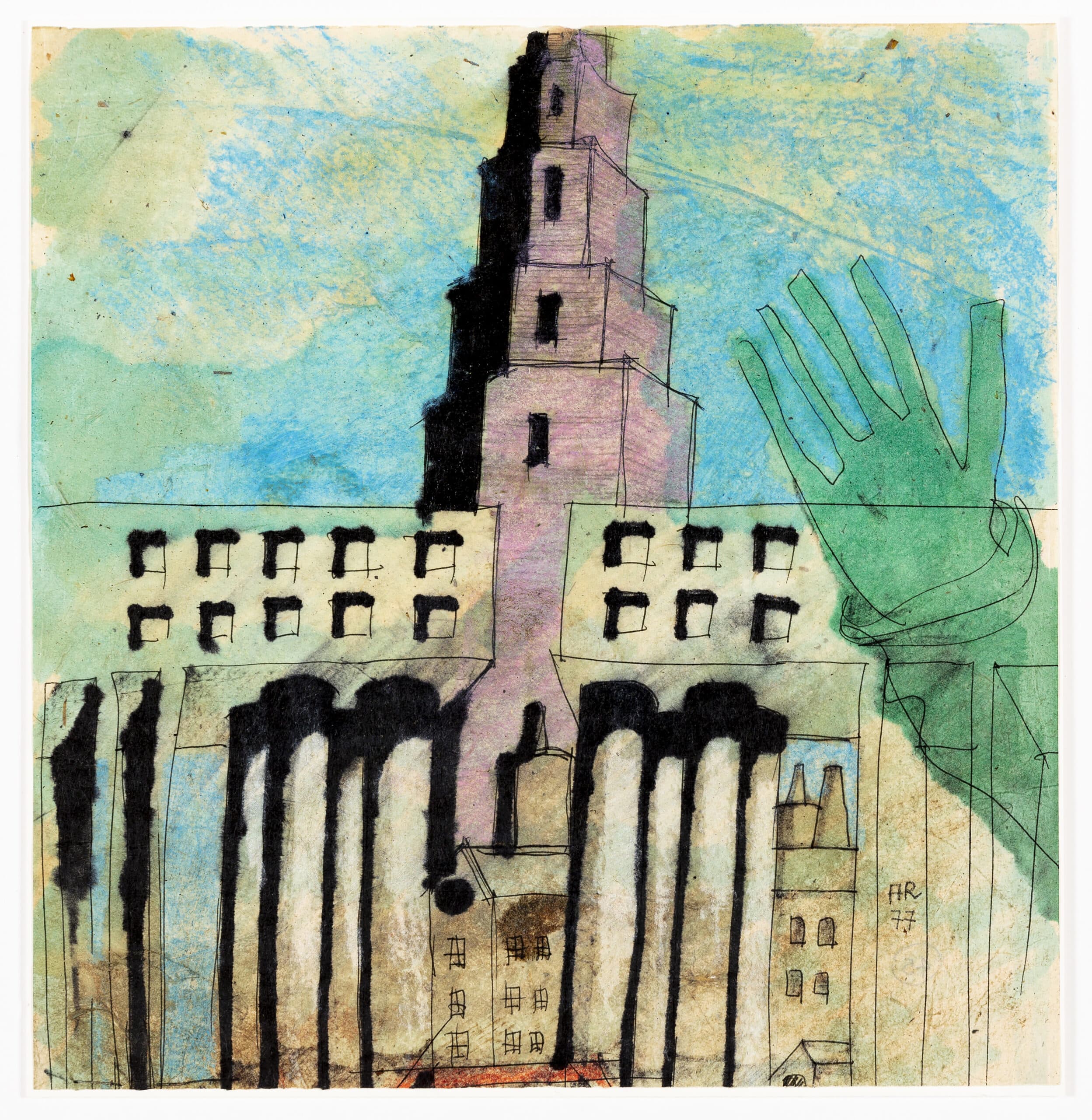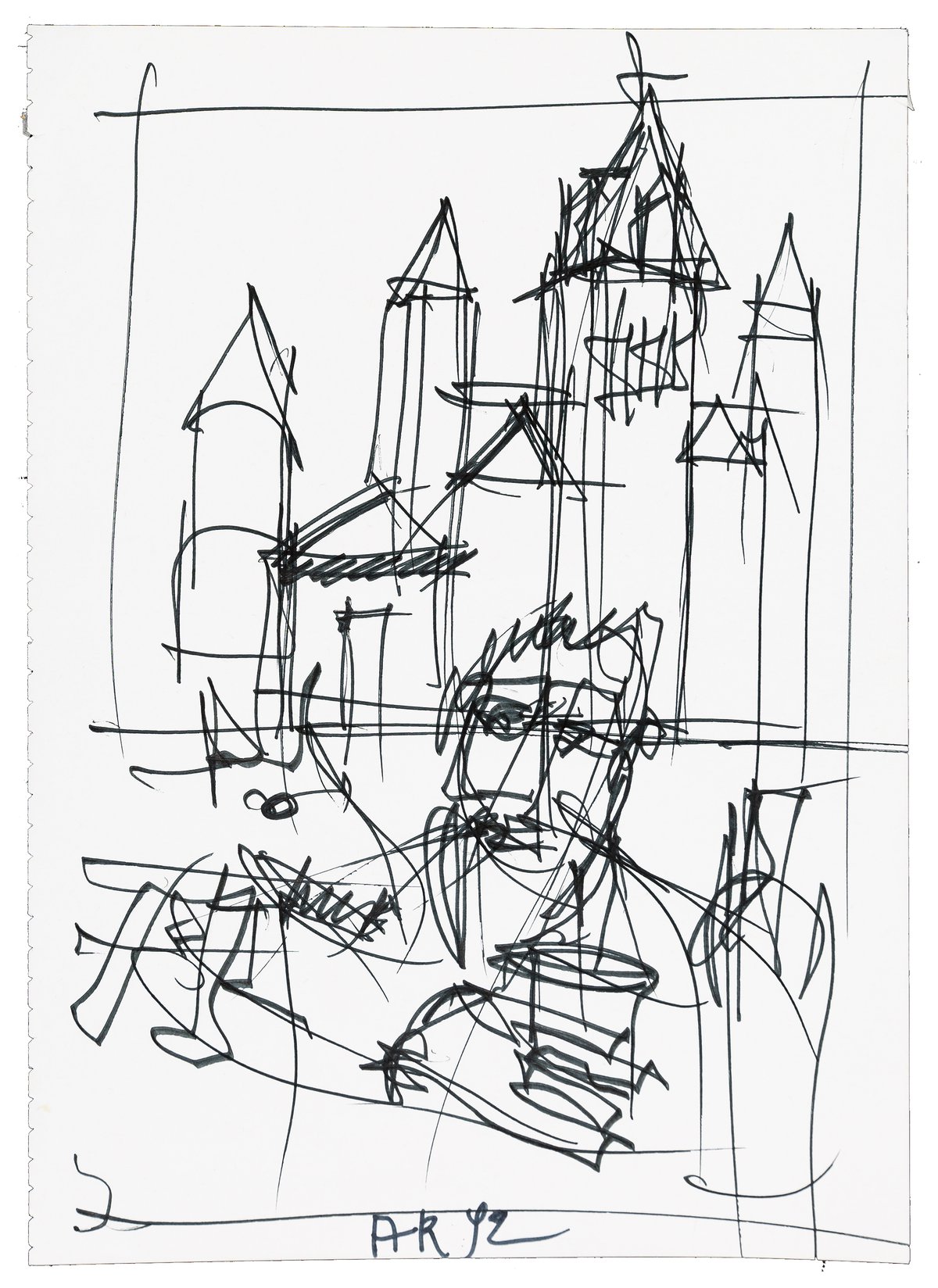Writing Prize 2020: Appropriation and Drawing

Similar to many of Rossi’s drawings, the Urban Fragment presents us with a collection of his most cherished forms – a primordial tower, the hand of a saint, and fragments of his own projects, such as the Gallaratese 2 housing complex in Milan and the Cemetery of San Cataldo. In a manner that could almost be called ritualistic, Rossi kept assembling and reconfiguring these forms into compositions that always portrayed a metaphysical quality. It is an undoubtedly conscious act, following the theory he laid out in his seminal text Architecture and the City (1966), in which he explains the city as a collection of urban artefacts ingrained in the collective memory, enabling the thread of history to extend to the present. But this act of taking one’s own projects, childhood memories and impressions from city walks, assembling them as fragments and laying them on paper, is a deeply intimate act based not on collective, but personal memory. Even though Rossi claimed that there is an uninterrupted continuity between his drawings and his built work, the fact he kept reintroducing his finished projects back to his drawings might indicate that the drawings themselves hold a deeper insight into the nature of his work. I believe they represent an intimate process of appropriation.
The Italian philosopher Giorgio Agamben describes the state of being in the world as a field of two polar tensions: appropriation and expropriation, having and not having. Through appropriation, we reach out to what we encounter in the world and try to make it our own. This incorporation is what defines our sense of self, it is a process that is constant, unconscious and repetitive. We reach out to words and form them as language, we collect objects and attach them to our identities, we inhabit spaces and make them our own. Perhaps the best example of spatial appropriation is evident in the alien feeling we encounter when inhabiting a new space, that slowly disappears as we make the space our own. But to what extent is the world truly appropriable? Let us consider the nature of our relation to our bodies, as that which is unconditionally proper to us. For instance, when our bodies are naked for others to see, it often brings an overwhelming feeling of shame. An insurmountable distance appears between us and the body, a radical impossibility of fleeing from oneself, an unalterably binding presence to the I. When that which is most intimate and proper to us is laid bare, it appears as the most foreign of things. Another example is found in language, something we hold inherently familiar, the form of our words and thoughts. Yet in the case of a lapsus, stuttering or forgetting, it reveals again that momentary distance which cannot be bridged. It is in this sense that Agamben understands the world as inherently inappropriable, and that deep inappropriable zone of our non-consciousness as the most intimate part of ourselves.
Drawing makes the inappropriable zone of the artist visible. It is an act of attempting to overcome the distance. Rossi’s ritualistic repetition of motifs is an act of reaching for the inappropriable zone of his non-consciousness. In doing so, he reveals his most valued memories that found their place throughout his work. His most persistent motif is the hand of the saint, as seen either emerging from beyond the image or placed between the buildings in his urban scenes. It is a reference to the colossal statue of San Carlo in Arona, which Rossi frequently visited in his childhood, and that made a lasting impression on his compositions. The figure of a giant human body amidst the Italian landscape undoubtedly contributed to the characteristic blurring of scales and sites in his drawings, where a building, a human body, and a pack of cigarettes could all hold equally prominent positions. It is also significant that his own built projects kept finding a place in his drawings. By doing so, Rossi breaks down the linear continuity of the drawing as a concept that leads to the built work. Instead, the built is reintroduced to the drawing almost in an act in which Rossi tries to reclaim the projects as his own. The materialisation of architectural concepts is in fact a process of expropriation from the architect, and I empathise with Rossi’s need to reclaim his own projects. Reminiscent of De Chirico’s paintings, Rossi frequently utilises stark, dark and angled shadows contrasted with the rest of the drawing. It gives his work a palpable metaphysical presence, but the shadow also renders parts of the image completely invisible. The shadows do not imply nothingness, they allude to what is hidden behind them – they signify the inappropriable. Rossi’s urban scenes have a definite spatial quality. They invoke imaginary (invisible) cities, but they also feel like private spaces. In fact, when I first came across his drawings, they reminded me of a particular room.
It can be said that a room is a mirror of its inhabitant. Perhaps one of the best examples of this interrelation can be found in Berggasse 19 in Vienna, where Sigmund Freund lived before his exile to England. This apartment was the birthplace of psychoanalysis, but most interestingly, the cluttered rooms revealed between the numerous antiques and objects the outlines of Freud’s own persona. Freud was famous for collecting all sorts of objects from distant parts of the world. These objects held an important role for Freud and his patients during his conducted counselling sessions, which is illuminated by the arrangement of objects in the rooms. For instance, the placement of articles on and around the couch – the heavy Persian rug hung vertically from the wall and anchored to the couch by a matching rug, the chenille cushions supporting the patient’s head, neck, and upper back, and the blanket and porcelain stove warming the patient’s feet – all create the impression of a protected enclave, a room within a room, a private interior space. Freud collected and arranged his Cabinet of Curiosities in a highly strategic manner. During the sessions, the patients would admit to thinking of the objects around them – the wallpaper, the gas-lamp, the sofa, and Freud claimed: ‘Then one knows at once that the patient has gone off into transference and that he is engaged upon what are still unconscious thoughts about the physician.’ In Freud’s understanding, and what his patients intuited – that room was Freud himself.

A parallel can be drawn to Rossi and his drawings. They are urban scenes with the quality of private interior space. In the ritualistic collection of his impressions, memories, and projects, and their assembling on paper, Rossi’s drawings reveal themselves as self-portraits.
In the words of Jorge Luis Borges:
‘A man sets himself the task of portraying the world. Over the years he fills a given surface with images of provinces and kings, mountains, bays, ships, islands, fish, rooms, instruments, heavenly bodies, horses, and people. Shortly before he dies he discovers that this patient labyrinth of lines is a drawing of his own face.’
Marko Skoblar is a recently qualified architect currently based in London.
This text was a prize winner in the long form category (1000–1500 words) of the Drawing Matter Writing Prize 2020.

– Aldo Rossi